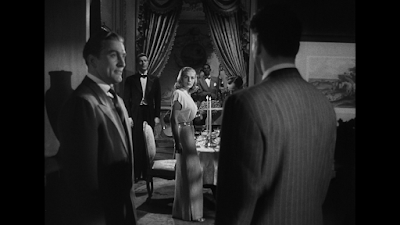CONFLICT
(1945)
Warner
Bros., 86m
Format:
35mm
ESCAPE IN THE FOG
(1945)
Columbia
Pictures Corporation, 65m
Format:
35mm
NOIR CITY: CHICAGO 2018
Music
Box Theatre, Chicago, IL
Friday,
August 17th, 2018 to Thursday, August 23rd, 2018
Host
Eddie Muller introduced CONFLICT and
ESCAPE IN THE FOG yesterday
afternoon to kick off the weekend of film
noir titles at NOIR CITY: CHICAGO 2018. This year's theme is the
reinstatement of the double feature, which means a proper A title is followed
by a B selection.
Filmed
in 1943, though released theatrically in June of 1945 due to an original story
rights dispute, the formative film noir
CONFLICT falls somewhere between the
genre's emergence and its classic cycle. In what would soon become a noir cliché (if it had not already), the
opening credits are accompanied by rainfall. Five years of marriage have taken
a toll on Richard Mason (Humphrey Bogart) and Kathryn Mason (Rose Hobart), who
bicker in the opening segment. Kathryn accuses her husband of having a thing
for her attractive younger sister Evelyn Turner (Alexis Smith), and Richard
quickly agrees! After an evening hosted by family friend Dr. Mark Hamilton
(Sydney Greenstreet), a talkative headshrinker, Richard gets into a car
accident with both sisters aboard. The women fare better than Richard, who is
left with a leg fracture after a surreal dream sequence fertilizes his darkest
impulses.
Marital
discord strikes a sour note in some of the most famous of film noirs, such as DOUBLE
INDEMNITY (1944), MILDRED PIERCE
(1945) and SCARLET STREET (1945), to
name just several. The presence of the crippled man—Richard in this case—is an
important interrelated motif. Wheelchairs, canes and crutches assist such men
who cannot or will not find a healthy release for sexual energy. The car crash
coincides with a trip inside Richard's warped mind and marks a major turning
point with no way back. His internal conflicts become externalized, and the
wife he no longer loves will not be in the way much longer, or so he thinks.
The
application of psychoanalysis would become a fixture of 1940s Hollywood cinema,
and was particularly prevalent in the noir
production, with its focus so often on the mental anguish of its lead
protagonist. CONFLICT was among the
first noir narratives to exploit the
theme, followed by many others such as THE
DARK MIRROR (1946), SHOCK
(1946), NIGHTMARE ALLEY (1947) and THE DARK PAST (1948). Richard plans the
murder of his wife cleverly enough to avoid prosecution through traditional
police investigation work, but psychology is used to disorient him, to make an
already unstable personality increasingly more brittle. In yet another theme
that would work its way into various film
noirs, Richard is forced to question whether his wife is really dead or if he
is going insane. Such confusion between the living and the dead is associated
more commonly with the horror film, in many ways the noir film's closest cousin. In its resolution, CONFLICT sounds the alarm for the union of police procedure with
psychoanalysis.
Director
Curtis Bernhardt would add to his film
noir credentials with POSSESSED
(1947) and HIGH WALL (1947).
Cinematographer Merritt B. Gerstad had shot THE UNKNOWN (1927), a fantastic silent horror film. The screenplay
was written by Arthur T. Horman and Dwight Taylor. Source material is credited
to the original story THE PENTACLE by Robert Siodmak and Alfred Neumann.
Humphrey Bogart would return to similar grounds in THE TWO MRS. CARROLLS (1947), where he again would portray a man
who prefers the Alexis Smith character over his wife.
CONFLICT is
available on DVD via Warner Archive and should be added to all film noir collections.
The
B portion of the double feature was ESCAPE
IN THE FOG, released the same year as CONFLICT,
but without the heavy dose of film noir
themes and motifs to be found in its A partner. The bottom half of the double
feature is a forgettable espionage thriller, with too many improbabilities for
its own good. It is mainly notable for being an early directorial effort from
Budd Boetticher (credited here as Oscar Boetticher Jr.). Boetticher would helm
a couple of proper noirs in the
future: BEHIND LOCKED DOORS (1948) and THE
KILLER IS LOOSE (1956). By his own admission, ESCAPE IN THE FOG is evidence of a filmmaker learning his trade on
the job.
As
our host Muller pointed out, screenwriter Aubrey Wisberg had a knack for
grinding out wartime B scripts, with credits that include THEY CAME TO BLOW UP AMERICA (1943), U-BOAT PRISONER (1944) and BETRAYAL
FROM THE EAST (1945). Lead actress Nina Foch would grace us with her
presence in some of the better film noirs
of the decade: MY NAME IS JULIA ROSS (1945), JOHNNY
O'CLOCK (1947) and THE DARK PAST
(1948). Top-billed Otto Kruger (SABOTEUR
[1942]) has precious little screen time. Shelley Winters jumps out at the
viewer in an early uncredited role as a cab driver.
ESCAPE IN THE FOG is
available on DVD from Sony Pictures.















